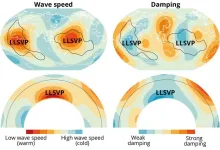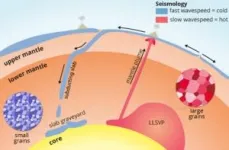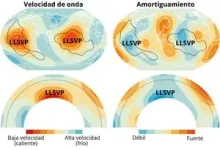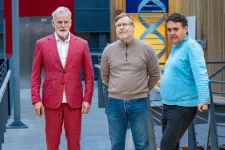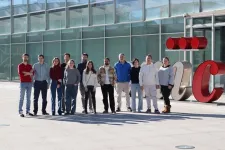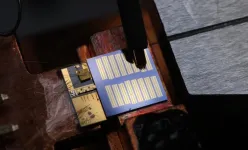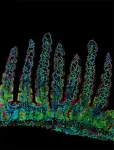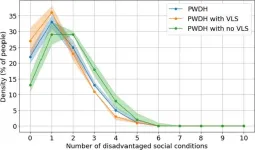(Press-News.org) Deeply hidden in Earth’s mantle there are two huge ‘islands’ with the size of a continent. New research from Utrecht University shows that these regions are not only hotter than the surrounding graveyard of cold sunken tectonic plates, but also that they must be ancient: at least half a billion years old, perhaps even older. These observations contradict the idea of a well-mixed and fast flowing Earth’s mantle, a theory that is becoming more and more questioned. “There is less flow in Earth’s mantle than is commonly thought.” This research will be published on January 22nd, 2025 in Nature.
Large earthquakes make the whole Earth ring like a bell with different tones, just like a musical instrument. Seismologists study Earth’s deep interior by investigating how much these tones are ‘out of tune’, because whole Earth oscillations will sound out of tune or less loud when they encounter anomalies. This way seismologists will be able to make images of the interior of our planet, just like a hospital doctor can ‘see’ through your body with X-rays. At the end of the last century, an analysis of these oscillations showed the existence of two subsurface ‘super-continents’: one under Africa and the other one under the Pacific Ocean, both hidden more than two thousand kilometres below the Earth’s surface. “Nobody knew what they are, and whether they are only a temporary phenomenon, or if they have been sitting there for millions or perhaps even billions of years,” says Arwen Deuss, seismologist and professor of Structure and composition of Earth’s deep interior at Utrecht University in the Netherlands. “These two large islands are surrounded by a graveyard of tectonic plates which have been transported there by a process called ‘subduction’, where one tectonic plate dives below another plate and sinks all the way from the Earth’s surface down to a depth of almost three thousand kilometres.”
Slow waves
“We have known for years that these islands are located at the boundary between the Earth’s core and mantle. And we see that seismic waves slow down there.” Earth scientists therefore call these regions ‘Large Low Seismic Velocity Provinces’ or LLSVPs. “The waves slow down because the LLSVPs are hot, just like you can’t run as fast in hot weather as you can when it’s colder.” Deuss and her colleague Sujania Talavera-Soza were keen to find out if they could discover more about these regions. “We added new information, the so-called ‘damping’ of seismic waves, which is the amount of energy that waves lose when they travel through the Earth. In order to do so, we did not only investigate how much the tones where out of tune, we also studied their sound volume.” Talavera-Soza adds: “Against our expectations, we found little damping in the LLSVPs, which made the tones sound very loud there. But we did find a lot of damping in the cold slab graveyard, where the tones sounded very soft. Unlike the upper mantle, where we found exactly what we expected: it is hot, and the waves are damped. Just like when the weather is hot outside and you go for a run, you don’t only slow down but you also get more tired than when it is cold outside.”
Grain size
Their colleague Laura Cobden, who specializes in the minerals that we find deep in the Earth, suggested to study the grain size of the LLSVPs. According to their American colleague Ulrich Faul, temperature alone cannot explain the absence of high damping in the LLSVPs. Deuss: ”Grain size is much more important. Subducting tectonic plates that end up in the slab graveyard consist of small grains because they recrystallize on their journey deep into the Earth. A small grain size means a larger number of grains and therefore also a larger number of boundaries between the grains. Due to the large number of grain boundaries between the grains in the slab graveyard, we find more damping, because waves loose energy at each boundary they cross. The fact that the LLSVPs show very little damping, means that they must consist of much larger grains.”
Ancient
Those mineral grains do not grow overnight, which can only mean one thing: LLSVPs are lots and lots older than the surrounding slab graveyards. Even more so: the LLSVPs, with their much larger building blocks, are very rigid. Therefore, they do not take part in mantle convection (the flow in the Earth’s mantle). Thus, contrary to what the geography books teach us, the mantle cannot be well-mixed either. Talavera-Soza clarifies: “After all, the LLSVPs must be able to survive mantle convection one way or another.”
Engine
Knowledge of the Earth’s mantle is essential to understand the evolution of our planet. “And also to understand other phenomena at the Earth’s surface, such as vulcanism and mountain building,” Deuss adds. “The Earth’s mantle is the engine that drives all these phenomena. Take, for example, mantle plumes, which are large bubbles of hot material that rise from the Earth’s deep interior as in a lava lamp.” Once they finally reach the surface, they cause vulcanism, like under Hawaii. “And we think that those mantle plumes originate at the edges of the LLSVPs.”
Large earthquakes
In this type of research, seismologists make good use of oscillations caused by really large earthquakes, preferably quakes that take place at great depths, such as the great Bolivia earthquake of 1994. “It never made it into the newspapers, because it took place at a large depth of 650 km and luckily did not result in any damage or casualties at the Earth’s surface,” Deuss explains. The whole Earth oscillations, or tones, are mathematically described in such a way that we can easily ‘read’ the damping (i.e. how loud the oscillation is) due to a specific structure and separate it from the wave speed (i.e. how much out of tune it is). “Which is impressive, because the damping of the signal is only one-tenth of the total amount of information that we can unravel from these oscillations.” For this type of research, it is not necessary to wait until another earthquake occurs. The data from previous earthquakes is just as useful. “We can go back to 1975, because from that year onwards, seismometers became good enough to give us data of such high quality that they are useful for our research.”
END
Subterranean ‘islands’: strongholds in a potentially less turbulent world
Earth’s mantle reveals hidden treasures
2025-01-22
ELSE PRESS RELEASES FROM THIS DATE:
Complete recombination map of the human-genome, a major step in genetics
2025-01-22
Complete recombination map of the human genome, a major step in genetics
Scientists at deCODE genetics/Amgen have constructed a complete map of how human DNA is mixed as it is passed down during reproduction. The map marks a major step in the understanding of genetic diversity and its impact on health and fertility. It continues 25 years of research at deCODE genetics into how new diversity is generated in the human genome, and its relationship to health and disease.
The new map, appearing today in the online edition of Nature, is the first to incorporate shorter-scale shuffling, ...
Fighting experience plays key role in brain chemical’s control of male aggression
2025-01-22
Like humans, mice will compete over territory and mates, and show increased confidence in their fighting skills the more they win. At first, a brain chemical called dopamine is essential for young males to master this behavior. But as they gain experience, the chemical grows less important in promoting aggression, a new study shows.
Dopamine has been linked to male aggression for decades. How past experiences might influence this relationship, however, had until now been unclear.
In experiments in rodents, a team led by researchers at NYU Langone Health boosted activity in dopamine-releasing cells in a part of the brain called the ventral tegmental area. The findings revealed that in ...
Trends in preventive aspirin use by atherosclerotic cardiovascular risk
2025-01-22
About The Study: Following landmark clinical trials and changes in guideline recommendations, self-reported primary prevention aspirin use decreased among older adults and adults with low atherosclerotic cardiovascular disease (ASCVD) risk for whom aspirin was not recommended, but also decreased among adults with higher ASCVD risk for whom aspirin may still be recommended. Despite these reductions, many patients with limited likelihood to benefit reported continuing to take aspirin.
Corresponding Author: To contact the ...
Sex differences in long COVID
2025-01-22
About The Study: This study found that female sex was associated with an increased risk of long COVID compared with male sex, and this association was age, pregnancy, and menopausal status dependent. These findings highlight the need to identify biological mechanisms contributing to sex specificity to facilitate risk stratification, targeted drug development, and improved management of long COVID.
Corresponding author: To contact the corresponding author, Dimpy P. Shah, M.D., Ph.D., email ShahDP@uthscsa.edu.
To ...
Medically recommended vs nonmedical cannabis use among US adults
2025-01-22
About The Study: The results of this study showed that adults ages 18 to 49 reporting medical-only or medical-nonmedical cannabis use vs nonmedical-only use had higher prevalence of cannabis use disorder at all severity levels and reported more frequent cannabis use. These findings suggest that medically recommended cannabis is not associated with reduced addiction risk compared with nonmedical use.
Corresponding author: To contact the corresponding author, Nora D. Volkow, M.D., email nvolkow@nida.nih.gov.
To access the embargoed study: ...
Spanish scientists discover how the gut modulates the development of inflammatory conditions
2025-01-22
A study led by David Sancho at the Centro Nacional de Investigaciones Cardiovasculares (CNIC) in Madrid reveals how an increase in intestinal permeability allows the natural gut bacteria to cross the intestinal barrier and reach the bone marrow, where they induce epigenetic changes—modifications that alter gene activity without affecting DNA sequence—in the stem cells that give rise to immune cells. The epigenetic changes induced by the translocated gut bacteria generate “trained” immune cells primed to respond more efficiently to future infections. However, this same ability to amplify the immune response can also aggravate the inflammatory conditions such as ...
Compact comb lights the way for next-gen photonics
2025-01-22
In the world of modern optics, frequency combs are invaluable tools. These devices act as rulers for measuring light, enabling breakthroughs in telecommunications, environmental monitoring, and even astrophysics. But building compact and efficient frequency combs has been a challenge—until now.
Electro-optic frequency combs, introduced in 1993, showed promise in generating optical combs through cascaded phase modulation but progress slowed down because of their high power demands and limited bandwidth. This led to the field being dominated by femtosecond lasers and Kerr soliton microcombs, which, while effective, require complex tuning and ...
New research reveals how location influences how our immune system fights disease
2025-01-22
Seattle, WASH.—January 22, 2025—The human immune system is like an army of specialized soldiers (immune cells) each with a unique role to play in fighting disease. In a new study published in Nature, led by scientists at the Allen Institute, La Jolla Institute for Immunology, and UC San Diego, researchers reveal how cells known as tissue-resident memory CD8 T cells, play unique and specialized roles based on where they are located within the small intestine. Tissue-resident memory cells provide a local first ...
AI in cell research: Moscot reveals cell dynamics in unprecedented detail
2025-01-22
Thanks to a new technology called Moscot (“Multi-Omics Single-Cell Optimal Transport”), researchers can now observe millions of cells simultaneously as they develop into a new organ—for example, a pancreas. This groundbreaking method was developed by an international research team led by Helmholtz Munich and has been published in the renowned journal Nature.
Until now, biologists had only a limited understanding of how cells develop in their natural environment—for instance, when they form an organ in the ...
New study finds social programs could reduce the spread of HIV by 29%
2025-01-22
January 22, 2025
New Study Finds Social Programs Could Reduce the Spread of HIV by 29%
Although HIV was used as a case study, the UMass Amherst researchers say their assessment tool has applications for other diseases
AMHERST, Mass. — Researchers at the University of Massachusetts Amherst have quantified the impacts of a constellation of social factors on the spread of HIV. Their study, published in Health Care Management Science, found that a hypothetical 100% effective intervention addressing barriers to HIV treatment and care from depression, homelessness, ...
LAST 30 PRESS RELEASES:
World-first discovery uncovers how glioblastoma tumours dodge chemotherapy, potentially opening the door to new treatments
A fatal mix-up: How certain gut bacteria drive multiple sclerosis
New AI tool identifies not just genetic mutations, but the diseases they may cause
Deep-learning model predicts how fruit flies form, cell by cell
Combination pills for high blood pressure may simplify treatment, improve long-term health
Immune system keeps mucosal fungi in check
Neurons within the brain use simple rules to localize genetic messages
Electrodes created using light
Second-hand gift-giving is a well-deliberated decision
How human interaction drove evolution to make bears less aggressive
National Poll: Few parents offer teens guidance on healthy eating during holiday season
Cannabis derivatives could provide new ovarian cancer treatments
Raising strong yeast as a petroleum substitute
Clues to the origin of hot Jupiters hidden in their orbits
Canada’s reduced pledge to Global Fund will impact domestic health
1 in 4 children with major traumatic injuries not cared for in pediatric trauma centres
Duke and Duke-NUS’ joint cross-population research to uncover "East-West" differences in disease and care
Scientists to ‘spy’ on cancer- immune cell interactions using quantum technology breakthrough
Tech savvy users have most digital concerns
Making lighter work of calculating fluid and heat flow
Normalizing blood sugar can halve heart attack risk
Lowering blood sugar cuts heart attack risk in people with prediabetes
Study links genetic variants to risk of blinding eye disease in premature infants
Non-opioid ‘pain sponge’ therapy halts cartilage degeneration and relieves chronic pain
AI can pick up cultural values by mimicking how kids learn
China’s ecological redlines offer fast track to 30 x 30 global conservation goal
Invisible indoor threats: emerging household contaminants and their growing risks to human health
Adding antibody treatment to chemo boosts outcomes for children with rare cancer
Germline pathogenic variants among women without a history of breast cancer
Tanning beds triple melanoma risk, potentially causing broad DNA damage
[Press-News.org] Subterranean ‘islands’: strongholds in a potentially less turbulent worldEarth’s mantle reveals hidden treasures
